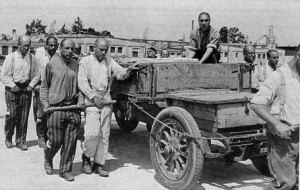The Roma and Sinti have their own term for their genocide at the hands of the Nazis. They call it the Baro Porrajmos which means the “Great Devouring.” The total number of Roma and Sinti (Gypsies) who were murdered in the Nazi death camps is still unknown. The US Holocaust Memorial Museum estimates that 220,000 were killed, but other sources put the total deaths at 500,000 or more than half the total number of Gypsies in all the countries of Europe.
After World War II ended, Germany gave compensation to the Jewish survivors, but compensation claims by the Gypsies were denied by the Germans in the 1950s on the grounds that the Gypsies had been persecuted under the Nazi regime because they were “asocial” or had broken the laws of the country, not because of racism. After a few years of protest by the Gypsies, compensation was finally given to the survivors.
In October 1999, I visited the Buchenwald Memorial Site near Weimar, Gemrany. I purchased the camp guidebook from the Buchenwald Museum.
The following quote is from the camp guidebook:
The racist persecution of the Sinti in Germany had already started under the cover of the Aktion Abreitsscheu Reich (i.e. during an action against “work-shy” people in Germany) carried out in 1938. Approximately 700 people called Burgenland Gypsies were deported to Buchenwald by way of the Dachau camp about one year later, i.e. in September 1939. They were put in Blocks 14 and 15. Many of them were driven to death in the quarry and in the excavation and stone-carrier parties. Hundreds of people belonging to the Romany Gypsies were provisionally put in Block 47 as the SS deported the survivors of the mass extermination of this people from the dissolved Auschwitz Gypsy Camp to the camps in Germany. Two hundred young Sinti and Romany Gypsies who were unfit for work were still sent back from Buchenwald into the gas chambers of Auschwitz in September 1944. Only a few survived among those who had to crush stones and dig tunnels in external working parties.
During the “work-shy action” in 1938, there were 4,500 vagrants and urban campers, who had no permanent address, rounded up and sent to concentration camps where they were forced to work against their will. There are no memorials at any of the former concentration camps for the “work-shy.” The persecution of the work-shy has been forgotten, except for the Gypsies who were sent to camps under this category.
Quelle: Scrapbookpages Blog
Stand: 20.02.2011


